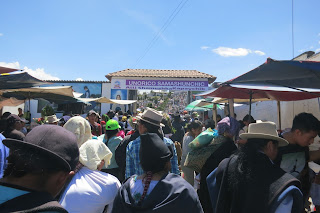Pijal with Archy Friends and Super Cool Tech
Sunday, I went to Pijal with Pepe (host
dad) and Mariauxi, where we met with Don Antonio (guide/local contact), David
Brown, and Mark. It was a super fun day with academic friends who are so welcoming
to me! I never feel like an outsider, even though I’m the only cultural
anthropologist and have a very different focus than the rest of the group. Instead,
they are all supportive of and interested in my research. David is always
especially enthusiastic, making me wish more academic interactions were like
this.
Pijal is of interest to archaeologists
because of its raised mounds (tolas, marked below) and agricultural mounds/ridges (camellones).
The camellones are a series of mounded
ridges and valleys used in agriculture to control water levels and crop
production. In times with an abundance of water, people planted their crops on
top of the mounds. The water in the little valleys held the warmth from the
sunlight and distributed that warmth at night, allowing for more even
temperatures in the soil throughout the day and night. In dryer periods, they
would plant their crops in the valleys between the mounded ridges to conserve
what little water they had. It’s a super smart system, when you think about it,
and it’s neat that you can still see these ridges today (sometimes even with
crops planted directly over them).
Mark was again here to do flyover
drone work of a few different archaeological sites that will then be turned
into 3D and topographic maps to help the archaeologists better understand the
sites.If you look closely, you'll see ridges along the mountain. When I came with Pepe and David last year, they thought they might be Incan terraces. Now, there's a debate about their origin, so Mark is mapping them to learn more information.
He seemed quite disappointed in himself that he had the same model drone
this year as last year, even though it was a different one because his other
drone needs some maintenance work and can't currently fly. After he got his
shots at the site, we got to take our annual “dronie” (a selfie from a drone).
Mariauxi suggested that next year we all get together again for a designated
play date so we can learn from Mark and give him an excuse to try out his new
tech! I think it’s an excellent idea.
Not to disappoint, Mark did have
other fun toys to play with! I was rather intrigued when he pulled out what
looks like a camera that had two shutters on the front. He explained that it
was a 3D camera, and each of the shutters function to like an eye, taking two
simultaneous photos that provide depth perception. He then use a device called
an Oculus-Go (think of the View Master toy for little kids – the red one you used
to play with where you would click a button and change the scene) to view the
3D images. He showed us a 3D photo of a rock ledge that allowed you to see the
detail of the stair-stepping of the rocks. It was kind of neat because you
could also see the edges of the photo, where it was less clears/less detailed/more
2D (on the right and left where the photo stopped). If you turned around, all
you would see was black. But the real treat is that the Oculus works with the
images taken by the drone! He pulled up aerial images of a few different sites
and let us look at them through the Oculus. You can turn in a 360 and see the
image in great detail, but you can also look down from a bird's-eye view (or in
this case from the drone’s view) to see the site from above. It is super freaky
and you feel a bit like you're going to fall. As someone who is afraid of
heights, it was almost scary but totally outweighed by the sheer awesomeness!
Mark told us that some psychologists are starting to use this technology to
help people overcome their phobias in a safer environment.
Oculus-Go is a really neat
technology partnership between Google, Facebook, and some other company I don't
remember. It works similar to the 360 photos that you can take on Facebook. In fact,
you could actually view the photos with a Google phone (like mine) for free,
but it wouldn't be as immersive of an experience. With the Oculus on, all you
can see is the image or video. It's a surreal experience because what your body
feels and what your eyes see do not line up.









Comments
Post a Comment